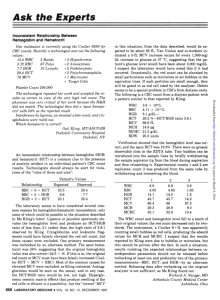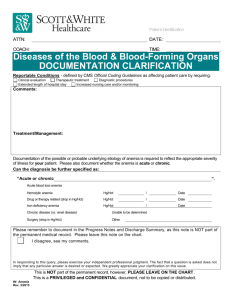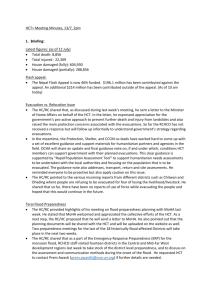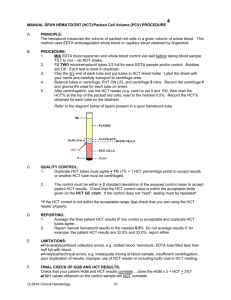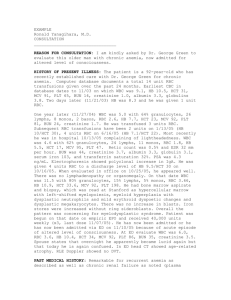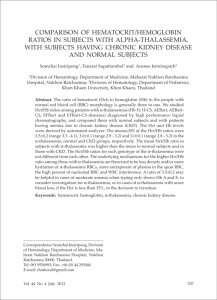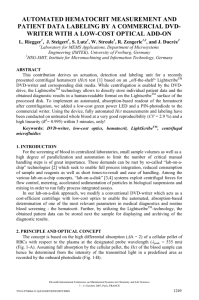VP01 Hematocrit and Hemoglobin Measurements
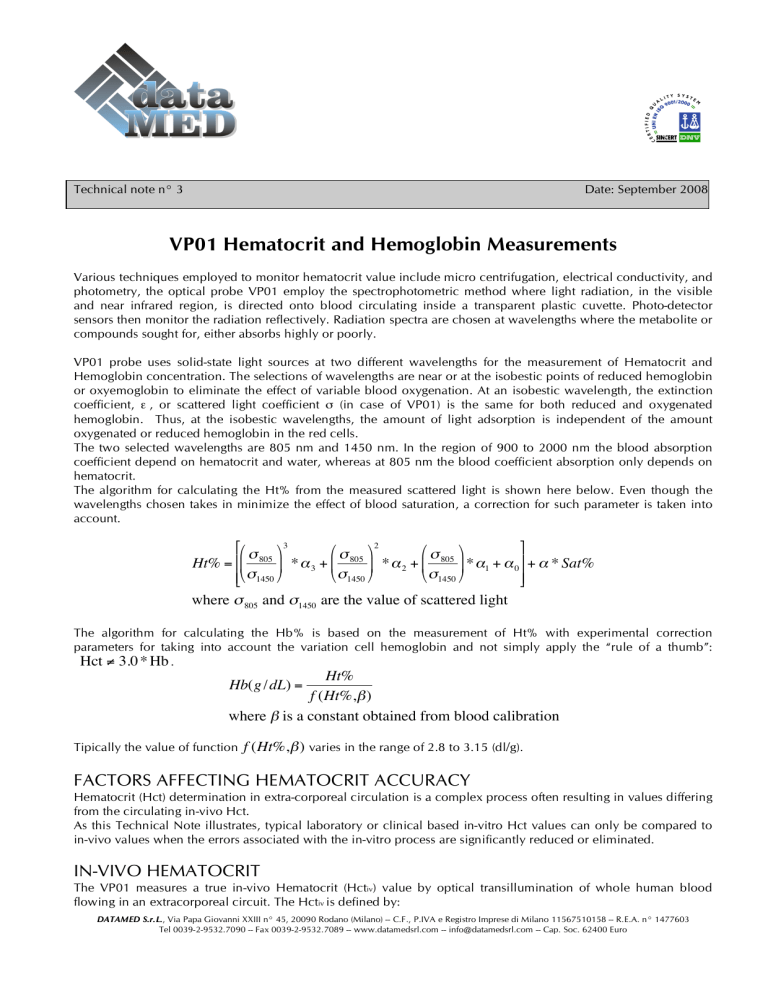
!
Technical note n° 3 Date: September 2008
VP01 Hematocrit and Hemoglobin Measurements
Various techniques employed to monitor hematocrit value include micro centrifugation, electrical conductivity, and photometry, the optical probe VP01 employ the spectrophotometric method where light radiation, in the visible and near infrared region, is directed onto blood circulating inside a transparent plastic cuvette. Photo-detector sensors then monitor the radiation reflectively. Radiation spectra are chosen at wavelengths where the metabolite or compounds sought for, either absorbs highly or poorly.
VP01 probe uses solid-state light sources at two different wavelengths for the measurement of Hematocrit and
Hemoglobin concentration. The selections of wavelengths are near or at the isobestic points of reduced hemoglobin or oxyemoglobin to eliminate the effect of variable blood oxygenation. At an isobestic wavelength, the extinction coefficient,
ε
, or scattered light coefficient
σ
(in case of VP01) is the same for both reduced and oxygenated hemoglobin. Thus, at the isobestic wavelengths, the amount of light adsorption is independent of the amount oxygenated or reduced hemoglobin in the red cells.
The two selected wavelengths are 805 nm and 1450 nm. In the region of 900 to 2000 nm the blood absorption coefficient depend on hematocrit and water, whereas at 805 nm the blood coefficient absorption only depends on hematocrit.
The algorithm for calculating the Ht% from the measured scattered light is shown here below. Even though the wavelengths chosen takes in minimize the effect of blood saturation, a correction for such parameter is taken into account.
Ht
%
=
*
,
+
#
"
%
$
805
"
1450
&
(
'
3
*
)
3
+
#
"
%
$
805
"
1450
&
(
'
2
*
)
2
+
#
"
%
$
805
"
1450
&
(
*
)
'
1
+ )
0
-
/ + )
*
Sat
%
.
where
"
805
and
"
1450
are the value of scattered light
The algorithm for calculating the Hb% is based on the measurement of Ht% with experimental correction parameters for taking into account the variation cell hemoglobin and not simply apply the “rule of a thumb”:
Hct " !
.
Hb
(
g
/
dL
)
=
Ht
%
f
(
Ht
%,
"
) where
"
is a constant obtained from blood calibration
Tipically the value of function f ( Ht %, " ) varies in the range of 2.8 to 3.15 (dl/g).
Hematocrit (Hct) determination in extra-corporeal circulation is a complex process often resulting in values differing
!
As this Technical Note illustrates, typical laboratory or clinical based in-vitro Hct values can only be compared to in-vivo values when the errors associated with the in-vitro process are significantly reduced or eliminated.
IN-VIVO HEMATOCRIT
The VP01 measures a true in-vivo Hematocrit (Hct iv
) value by optical transillumination of whole human blood flowing in an extracorporeal circuit. The Hct iv is defined by:
DATAMED S.r.L.
, Via Papa Giovanni XXIII n° 45, 20090 Rodano (Milano) -- C.F., P.IVA e Registro Imprese di Milano 11567510158 -- R.E.A. n° 1477603
Tel 0039-2-9532.7090 -- Fax 0039-2-9532.7089 -- www.datamedsrl.com -- info@datamedsrl.com -- Cap. Soc. 62400 Euro
Hct
iv
=
RBC
volume
+
Plasma
volume)
) (
RBC
volume
Where RBC= Red Blood Cell
Because this optical technique does not affect the blood flow or physiology and does not require removal of a
!
by intravascular dosage of heparin and physiologic changes. Techniques which requires aspiration of a blood sample change the sample status to “in-vitro” and introduces at least three potentially significant errors:
DILUTION, MEAN CELLULAR VOLUME (MVC) and TECHNIQUES ERRORS.
Hence,
Hct
=
Hct
iv
+
Dilution
+
MCV
+
Techniques errors
in-vitro errors
IN-VITRO HEMATOCRIT ERRORS
Dilution Errors
!
Dilution Errors are a direct result of not accounting for diluent volume to the overall blood volume of the sample or imprecise measure of blood volume in the test tube. For example, even with a precise blood sample of 5 ml, the
0.05 ml of EDTA anticoagulant contained in a purple-top test tube leads to a – 0,5 % Hct in-vitro error for a 50%
Hct iv
.
Dilution Error Potential: -0,5 to –1Hct units
MCV Errors
Changes in the MCV may dramatically affect in-vitro Hct values. Some MCV changes can be related to patient noncompliance (i.e. due to high [Na + ] intake or Overhydratation: [Na + ]< 135 mEq/L). The most serious MCV error is associated with shrinkage of the RBC’s due to effect of the anticoagulant like CPDA1 or EDTA, which is contained in purple-top test tubes. (Red-top test tubes contain no anticoagulant and hence do not produce MCV changes or errors).
An error due to anticoagulants induced red cell shrinkage may result in as much as a 10% Hct change. This is especially true if the sample volume of blood in the test tube is less than required by specification.
Since most Hct determination methods require removal of blood from the in-vivo environment and therefore require use of a diluent or anticoagulant, MCV errors are impossible to avoid unless a red-top tube is used in lieu of an EDTA based purple-top tube. This is due to the functional dependence of Hct on MCV as given below.
Functional dependence of Hct on MCV
The functional dependence of the two most common reference standards for Hct determination: the microcentrifuge and the Coulter Counter (CC Hct), is defined below:
Microcentrifuge Hct (Spun Hct)
# of RBC’s = number of red Blood Cells
R v
= RBC volume
= (MCV)*( # of RBC’s)
P v
= Plasma volume hence
Spun Hct =
"
$
#
1 +
1
Pv
R v
%
'
& and therefore:
DATAMED S.r.L.
, Via Papa Giovanni XXIII n° 45, 20090 Rodano (Milano) -- C.F., P.IVA e Registro Imprese di Milano 11567510158 -- R.E.A. n° 1477603
Tel 0039-2-9532.7090 -- Fax 0039-2-9532.7089 -- www.datamedsrl.com -- info@datamedsrl.com -- Cap. Soc. 62400 Euro
!
Spun Hct =
"
# 1 +
%
[
1
( MCV ) (
Pv
) ]
&
'
$
Coulter Counter Hct .
The CC Hct method of determining Hct is based on a known MCV and the number of Red
Cells:
!
CC Hct =
[ (
MCV
) ( ) ]
sample volume
Both standards are MCV dependent: thus both are affected by MCV Errors which are primarily the direct results of
EDTA (with respect to heparin) and may range from a minimum Hct reduction of –1.8 Hct units in Hct depending upon relative concentration of EDTA 2
1 to a 11% change
. (Even the use of isotonic agent, to compensate for EDTA
!
The VP01 is calibrated to “normal” MCV ranges (from 80fL-to 100fL)
MCV Error Potential: -1,8 to –5 Hct units
3 .
Technique Errors
Technique errors are categorized as Handling, Methodology or Sampling Errors.
These errors may be cumulative and therefore may offset or even trivialize MCV errors. At best, technique errors are not negligible.
Handling Errors
Handling errors may result from:
Hemolysis of the sample
Contamination of the sample
Handling Error Potential: ±1 to 3 Hct units
Methodology Errors
Methodology errors may be equipment related due to misapplication of protocol:
Operator error
Calibration Problems
(1 to 3 Hct units)
(1 to 3 Hct units)
Inappropriate conversion errors (e.g. use of hemoglobin to determine Hct). When the mean cell hemoglobin concentration about 0.33, then
Hct " 3.0 * Hb
Also included, as methodology errors are errors specifically associated with microcentrifuge use, all of which may produce individual errors from ± 1 to 3 Hct units
!
4 unless otherwise noted:
Trapped plasma volume
“Short cut” spinning with an in-expensive device or abbreviated method
Lack of precision in following microcentrifuge specification for Hct determination
Capillary tube leakage from porous plug ends
(+1.4 units)
(±2.0 Hct units)
1 Gotch F, et al.: “Comparison of Conductivity measured hematocrit to microhematocrit”. ASAIO Trans 37:M138-139, 1991.
2 Brittin G, et al.: “Elimination of error in hematocrit produced by excessive EDTA”. Tech Bull Regist Med Technol 39:246-249, 1969.
3 UIHC Pathology Handbook. University Pathology consortium.
4 Henry JB; “Clinical Diagnosis&Recommendations for Reference Method for the Packed Cell Volume. ICSH Standard 2001. International
Council for the Standardization in Hematology. Laboratory Hematology 7: 148-170, 2001 Carden Jennings Publishing Co. Ltd.
DATAMED S.r.L.
, Via Papa Giovanni XXIII n° 45, 20090 Rodano (Milano) -- C.F., P.IVA e Registro Imprese di Milano 11567510158 -- R.E.A. n° 1477603
Tel 0039-2-9532.7090 -- Fax 0039-2-9532.7089 -- www.datamedsrl.com -- info@datamedsrl.com -- Cap. Soc. 62400 Euro
Setting of red cells in the blood sample before transfer to a capillary tube
Air pockets in the capillary tube
Inappropriate reading of meniscus (e.g. including buffy coat or use of an inappropriate scale in lieu of microcalipers)
Methodology Error Potential: ±1 to 5 Hct units
Sampling Errors
Sampling errors are specifically related to sampling for comparison vs. VP01:
Exact VP01 Hct iv
value not noted at sample time
Sampling during priming of extracorporeal circuit
Sample during period of no blood flow
Sampling Error Potential: ±0.5 to 1 Hct units
Summary of In-Vitro errors
In general, Dilution, MCV and Technique Errors are inherent to in-vitro Hct determination and cannot be ignored.
The overall potential error can be as high as ± 5Hct units.
Reference and Standards
Instruments
The VP01 has been calibrated to Microcentrifuge Standard using ex-vivo whole blood from Donors with “normal”
MCV range (from 80fL-to 100fL) and SBE (Standard Base Excess) controlled int the range from -10 mEq/L to +10 mEq/L.
Specification for Microhematocrit accuracy.
Accuracy through microcentrifugation of whole blood requires:
Minimal amounts of heparin anticoagulation in blood samples
15,290 g force
12000 RPM
Spin time: 7 minutes
Precision micrometer with magnification used for column height measurement
Additional Reference
Abnormal [Na +
Changes in [Na
] levels
+ ] adversely affect the microcentrifuge derived Hct values according to the following relation:
12 mEq/L increase in [Na + ]
≈
1 Hct unit decrease due to MCV changes
Sources of abnormal sodium concentration:
Blood Bank with (Na Citrate) ≈ 165 mEq/L
Normal saline as a diluent ≈ 154 mEq/L
Overhydratation [Na + ] < 137 mEq/L
Hemolysis
Hemolysis may affect hematocrit determination, although no changes in the VP01 measurement have been noted for plasma hemoglobin levels below 3 g%
Abnormal Patient conditions
The VP01 has not been tested for all the possible blood conditions. Some of these conditions include sickle cell anemia, macrocytic anemia and hyperlipidemia. Certain drugs and/or medications may cause idiopathic hyperlipidemia such as the prostaglandins (e.g. Alprostadil) and the intralipids given intravenously. These
DATAMED S.r.L.
, Via Papa Giovanni XXIII n° 45, 20090 Rodano (Milano) -- C.F., P.IVA e Registro Imprese di Milano 11567510158 -- R.E.A. n° 1477603
Tel 0039-2-9532.7090 -- Fax 0039-2-9532.7089 -- www.datamedsrl.com -- info@datamedsrl.com -- Cap. Soc. 62400 Euro
conditions may cause an offset in Hct measurements
In the table below are listed the ranges of MCV related to the most common pathology
Condition MCV (fL) Mean and Approx.
89 (82-100)
Range
Normal
Iron deficiency anemia)
Anemia of chronic disease
Thalassemia Minor
74 (53-93
86 (70-95)
68 (56-75)
Thalassemia Major
Hemoglobin H disease
HGB E trait, AE
HGB E disease, EE
(48-72)
70 (53-88)
73 (71-78)
64 (58-76)
HGB C disease, CC 74 (55-93)
Hereditary sideroblastic
Anemia
77 (49-104)
Idiopathic sideroblastic anemia 104 (83-118)
DATAMED S.r.L.
, Via Papa Giovanni XXIII n° 45, 20090 Rodano (Milano) -- C.F., P.IVA e Registro Imprese di Milano 11567510158 -- R.E.A. n° 1477603
Tel 0039-2-9532.7090 -- Fax 0039-2-9532.7089 -- www.datamedsrl.com -- info@datamedsrl.com -- Cap. Soc. 62400 Euro
